
Felixstowe is a Victorian seaside family resort eighty five miles from London with good rail and coach links. A beautiful pier, with gardens lining Undercliff Road from the hotels leading down to a yellow sand and shingle beach, are in stark contrast to the huge container handling port and frenetic container loading and unloading operations by the 29 huge gantry cranes at two terminals, Trinity Terminal and South/ Landguard Terminal in the south of the town. The pier was opened in August 1905 with a total length of 2,640 feet, but now is shorter and used to have steamer services to various destinations. Across the Deben river to the north, radar pioneers at Bawdsey Manor toiled to develop early warning long distance radar systems that gave the vital edge in forewarning of the strength of enemy air formations approaching the coast during the Battle of Britain in August and September of 1940.
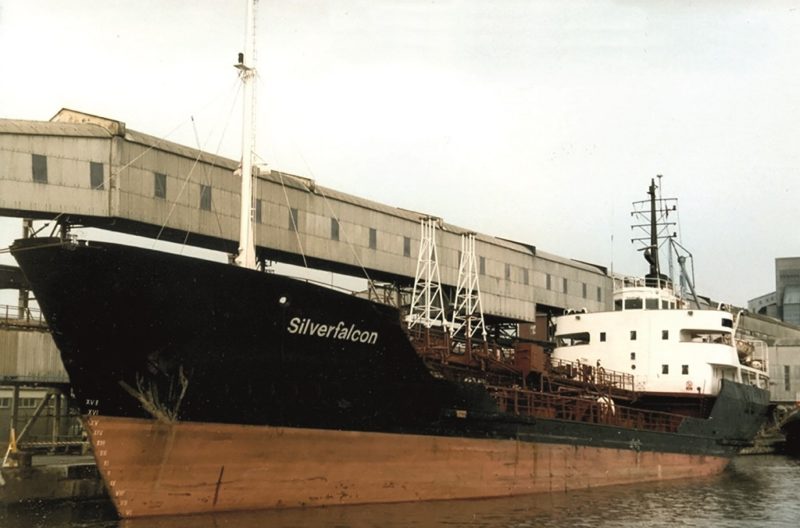
HISTORY OF THE PORT OF FELIXSTOWE
A fort at Landguard Point, immediately east of the South/Landguard Terminal and the ferry for foot passengers to Harwich, protected the town from a Dutch invasion that was made after the invasions of England in 1066 by both the Norsemen and the Normans. In June 1667, the Dutch Navy under Michel de Ruyter sailed up the Thames to Gravesend, and then captured the fort at Sheerness before sailing up the Medway to Chatham and bombarded various strongpoints, and caused much damage to the English fleet at Chatham. Two weeks later, two thousand Dutchmen of a strong force of invasion troops landed on Felixstowe beach and advanced to Landguard Fort, but were defeated in a long battle with 500 artillerymen led by Nathaniel Darrell.
A later strong pentagonal fort with casemate batteries was built in 1718, with four 6 inch guns and two sets of twin six pounder guns installed in Darrell’s Battery in World War II, and which fired on German midget submarine attacks on Harwich Harbour and German minelayers. Landguard Fort was also a vital H/Q and Plotting Base for the heavy aircraft formations necessary to defend against German air attacks in the Ipswich and Harwich area in World War II, as well as a Naval Port War Signal Station controlling ship movements in and out of Harwich harbour. It also controlled remotely large defensive minefields in the harbour entrance. Military operations at the fort ended in 1987, and the fort is now under the guardianship of English Heritage and is open to the public.
Facing the busy ferry port of Harwich, a roughly square dock was built by the Felixstowe Railway and Dock Company, previously the Felixstowe Railway and Pier Company, with berths for small ships on three sides, complete with grain warehouses and rail sidings, and was opened on 7th April 1886 for trade by the steamer Crathie. A big team of labourers with the help of steam powered cranes had taken four years to dig the dock. The fourth side of the dock had the entrance and two small piers, one longer than the other, with Colonel George Tomline, founder of the port company in 1875, dying three years later in 1889. Tomline House, HQ of the present Port of Felixstowe, commemorates his name.
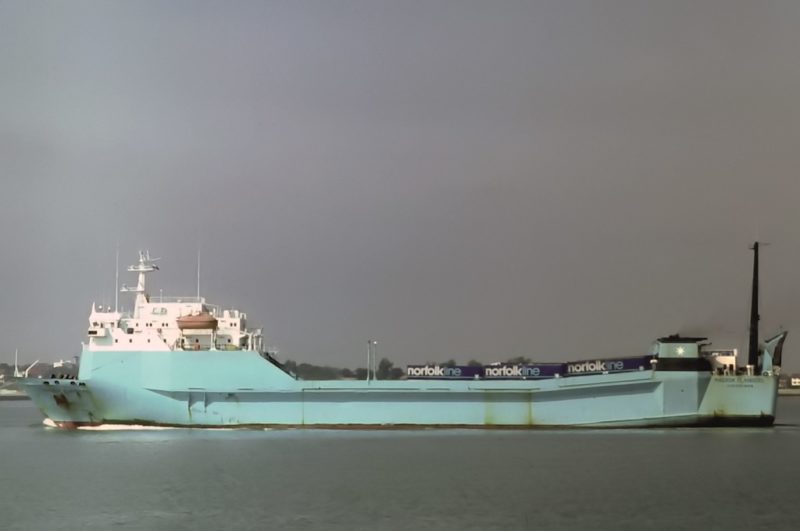
The dock was used during World War I as a destroyer and minesweeper base, and during World War II as a Motor Torpedo Boat (MTB) base, Motor Gun Boat (MGB) and for Air/Sea Rescue craft. Two storage oil tanks of a total capacity of 5,000 tons of fuel oil had been built in 1911 specifically for Admiralty bunkering use. The 1st and 4th Flotillas of MTBs were based from 1940 to 1942 at Lowestoft, Felixstowe and Harwich of up to 72 in feet with a fast attack speed of 40 knots and were equipped with two torpedo tubes and machine guns. MGBs were of the same length and were fitted with six machine guns, a twin Oerlikon gun, and a six pounder. Felixstowe crews had accommodation in the Little Ships Hotel at the dock at night, very close to their boats for immediate action, with crews living onboard during daylight hours.
In 1951, the derelict Port of Felixstowe was acquired for £24,000 by Gordon Parker, an agricultural merchant, and further grain and other commodity warehouses were built, and molasses and palm oil was stored in small quantities in the former Royal Navy oil tanks. Ian Trelawny was the first Manager of the port, he had commanded MTBs to attack German shipping from the port in World War II. Concrete posts and kerbs for road use were made by the port workforce while trade was being developed. Felixstowe Dock had a dredged depth of six metres, the East Quay of the dock was developed in 1959 for the bulk grain and palm oil trades, with larger tanks added in 1961. Shippers came to Felixstowe because of the forward looking management, no history of bad labour relations, and the construction of new and modern facilities.
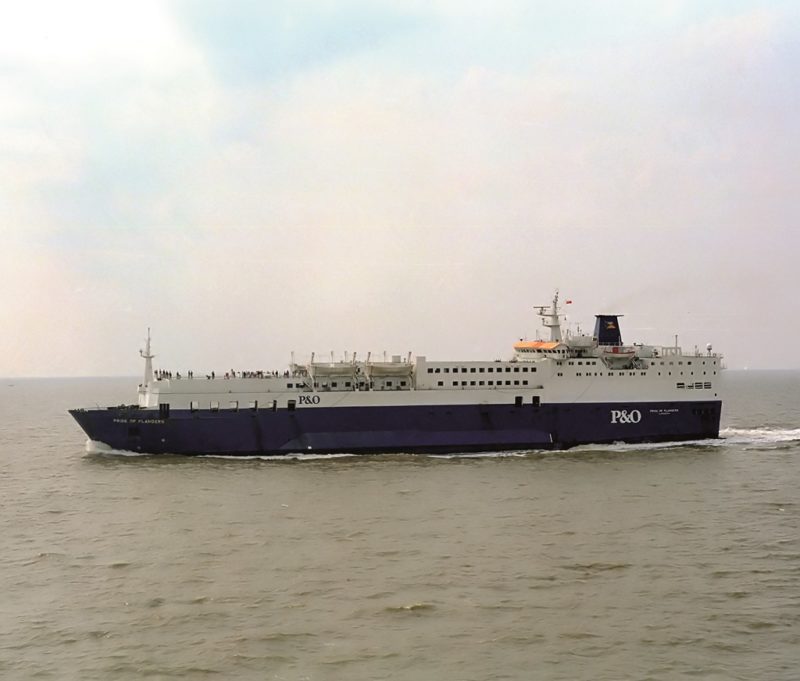
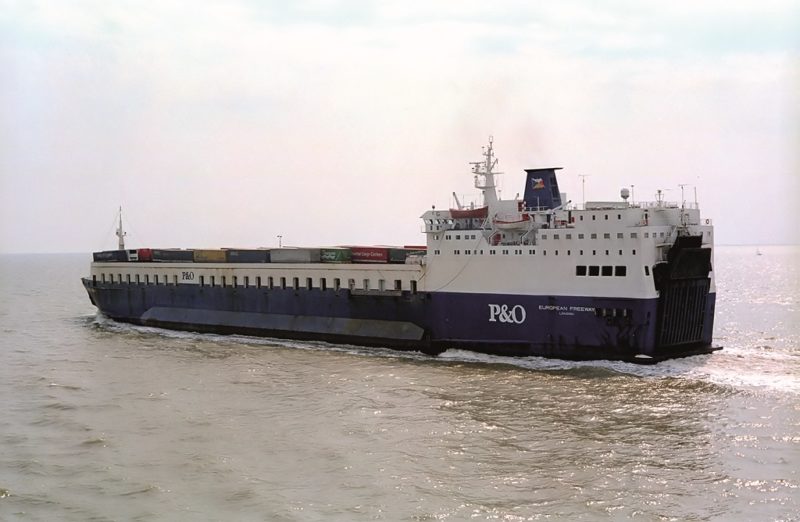
The Felixstowe Cold Store was opened in 1963 with new cold stores and warehouses completed, with oranges, lemons, melons and citrus fruit arriving from Mediterranean ports and apples from Bluff at the southern tip of South Island, New Zealand. Felixstowe total trade had reached 376,000 tons in 1964, and a long ‘L’ shaped oil jetty for palm oil imports was constructed in that year extending into the river, and a year later the first ro-ro berth was opened near the dock. The chemical tanker Silverfalcon of 1,310 grt and built in 1966 at Lodose broke loose from her moorings in the Great Storm of 1987 and collided with the oil pipeline jetty near the Dock Basin, neither the oil jetty or Felixstowe Old Dock exist today, with the latter infilled in 2008.
The Port of Felixstowe began to be developed from 1967, along with the Port of Rotterdam, as ideal ports for the first container ships trading to Europe for Sea-Land Service and American Export Lines of the U.S.A., Hapag of Germany, and the Dutch Nedlloyd Group, later formed in 1970. The deal with Sea-Land Service was for £3.5 million using container ships of 15,000 grt and 500 TEU capacity, and Felixstowe had a container handling quay in operation at Landguard on 1st July 1967 with an alongside depth of 33 feet. In the first year of operation, the terminal handled over 18,500 TEU of containers, and by March 1968 the quay was of length 800 feet and with two Vickers Paceco portainer handling cranes of 30 tonnes capacity. This Landguard quay was originally to be called the New South Quay, and was extended by 700 feet to 1,500 feet in 1973 with another Paceco portainer handling crane of 40 tonnes lift capacity added.
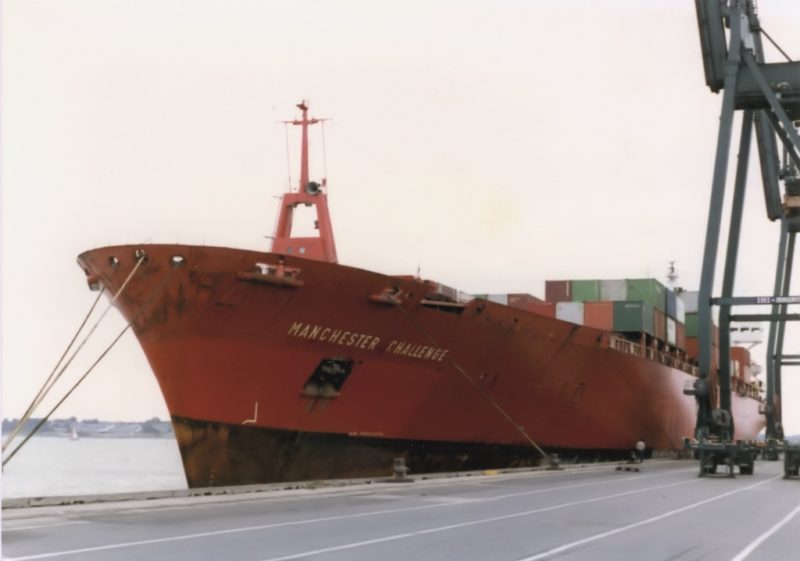
The port handled 3.8 million tonnes of cargo in 1974, a tenfold increase in ten years since the transformation of the port. The port had developed by the late 1970s into a medium sized port handling 3.0 million tonnes of imports per year and 1.6 million tonnes of exports per year. Working hours were two shifts of 0800 to 1600 hours and 1600 to 2400 hours, overtime at the weekend by written request before 1500 hours on Friday, and an alongside ship repair welding and cutting service, with underwater divers. The port handled over 400,000 TEU of containers in 1980, and four years later the total trade throughput was 9.1 million tonnes.
Gaselee Tugs of London stationed their first tug, Hooligan, at Felixstowe in November 1963 followed a month later by Agama. Ten Thames tugmen and their families were encouraged to move to Suffolk, and by 1974 there were three tugs available in Sauria of Gaselee, Ionia of William Watkins and Sun XVIII from the Alexandra Towing Ltd. In 1975, William Watkins and London Tugs were taken over by Alexandra Towing Ltd., and in that year Sauria, Deben (ex Sun XXII) and Egerton were stationed at Felixstowe. Alexandra Tugs over the years at Felixstowe included Brightwell (1986) and Deben (1990) of 371 grt and 40 tons bollard pull, Egerton (1965), Ganges (1982), Sauria (1968), Victoria (1972), Alfred (1971) and Deben (1960) until they were taken over by the Howard Smith Group of Australia in 1992. Sauria was built by Richard Dunston Ltd. at Hessle for Gaselee (Felixstowe) Ltd., and all of the Gaselee London and Felixstowe tugs were sold to Alexandra Towing Ltd. in 1975.
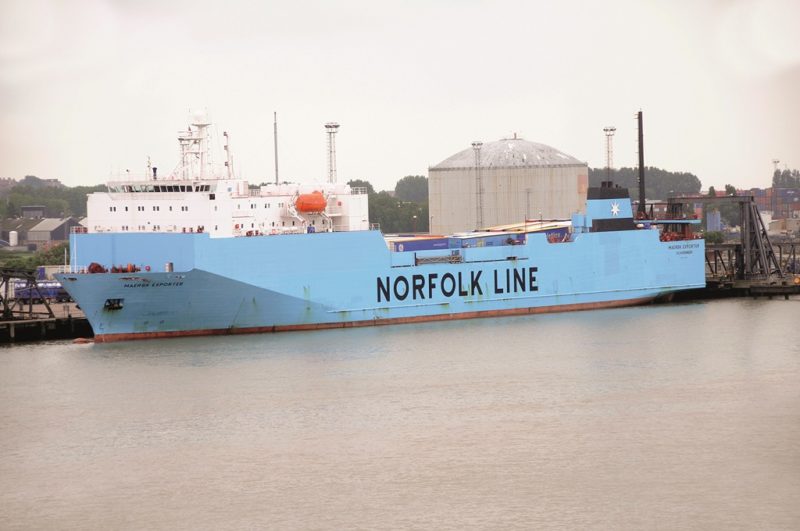
Felixarc Marine Ltd. have used the tugs Felix-tow (1957), Gray Delta, Gray Echo and Gray Test, the latter of 55 grt and built in 1996 by Damen at Gorinchem in Holland, and the pontoon crane barge Gray Mammoth for barge and salvage work. An example of the latter was the raising of a Harrier jump jet that had crashed into the sea at the Lowestoft Air Show in 2002, and it was lifted by Gray Mammoth from five metres of water and dismantled into her wings and fuselage to determine the cause of the crash. Felixarc Marine Ltd. is part of Svitzer Towage at Felixstowe.
Ship’s documents required on arrival included crew list, passenger list, tobacco, spirits and stores lists, and certificates of de-ratting, health, load line, safety equipment, gross, net and deadweight tonnage, nationality and full details of imported cargo if any. Felixstowe General Cargo Brokers Ltd. were agents for liner and tramp cargo, container and trailer operation, and freight forwarding. Telephone, telex and telegram cables with a full port operation service were available, Felixstowe port code of GBFXT. Anchorage for small coasters was possible in the Stour river or on the North Shelf close to Felixstowe Dock and opposite Parkeston Quay in Harwich at this time.
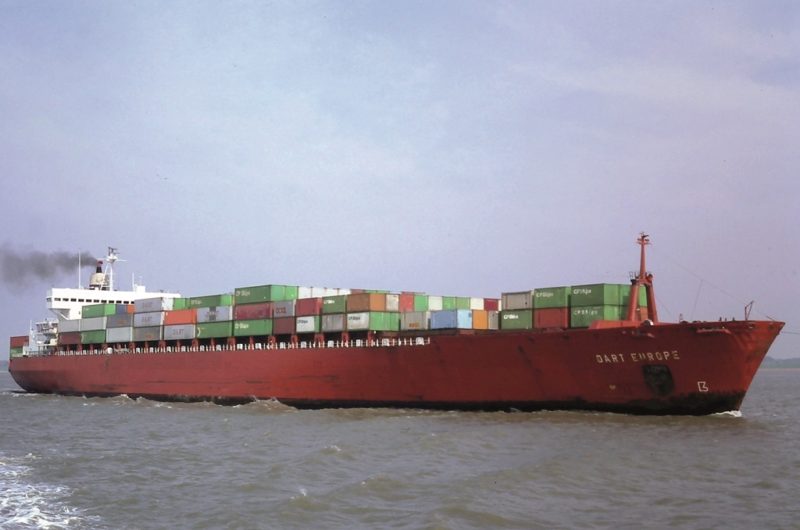
The dredged and lighted approach channel enabled ships drawing up to 25 feet to enter the port at the mouth of the rivers Stour and Orwell at any state of the tide.
The port had the following facilities:-
Landguard Container Terminal had 3 container berths of total length 2,040 feet with an open yard of 28 hectares and a warehouse of 2,415m2. Three Paceco portainer lifting cranes and other stackers and forklifts moved small quantities of 50 or 100 containers at a time from the first container ships to arrive.
Ferry Terminal had Ro-ro berths 1 and 2 to the south of Felixstowe Dock, and Ro-ro berths 3 and 4 to the north of Felixstowe Dock. Ferries up to 450 feet in length were able to berth. A floating pontoon of dimensions 45 by 27 metres was connected to the HGV and trailer area by three steel girder bridges for simultaneous discharge from two decks. One electric travelling crane of 32 tonnes capacity.
Felixstowe Dock had an East quay of length 131 metres, North quay of length 195 metres, South quay of length 186 metres, with vessels up to 350 feet in length accepted into the dock. 7.7 hectares of open yard, transit sheds of 48,272m2 and a grain silo of 6,400 tons with a mobile pneumatic grain discharger with a rate of 30 tons per hour, reasonable for this time and size of operation. Two cranes of 32 tons capacity and eleven mobile cranes of up to 27.5 tons capacity.
Oil Berth for tankers up to 600 feet could berth at the ‘T’ jetty to discharge into 117 tanks totalling 70,640m3 via two hose connections of 4 and 6 inches in diameter. A tanker cleaning vessel and a barge for the immediate removal of oily and ballast water was available, as well as a 30 ton floating crane and several open barges and cargo pontoons for use throughout the port.
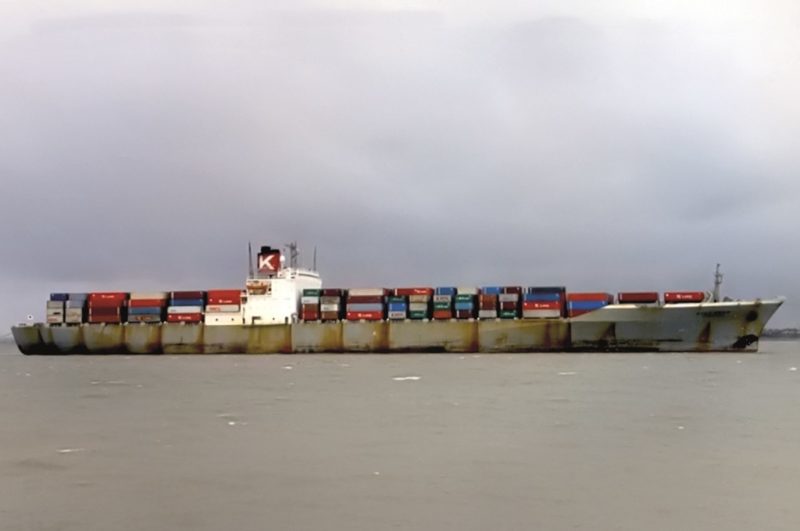
PORT OF FELIXSTOWE RO-RO FERRY SERVICES
The Atlantic Steam Navigation Company, founded by Colonel John H. Bustard, operated a service from Felixstowe to Rotterdam from 12th July 1965 using the stern loader Gaelic Ferry of 2,756 grt and 1,701 dwt from No. 1 ro-ro berth when she loaded 34 HGVs and 80 cars, built by Swan, Hunter & Wigham Richardson Ltd. on the Tyne. She had accommodation for 44 passengers and 90 vehicles, or 57 vehicles and 52 TEU of containers on her car deck on low loaders. Europic Ferry of 4,190 grt, was also completed in 1967 by the Neptune Yard of Swan, Hunter & Wigham Richardson Ltd. on the Tyne. She joined Gaelic Ferry using Number 2 berth, and was of 2,760 dwt with accommodation for 44 passengers, with her car deck taking 112 cars or 69 cars and 82 TEU containers on low loaders. She had a service speed of 16 knots from twin Sulzer Brothers diesel engines of a total of 5,200 bhp.
Felixstowe saw the opening of a ro-ro passenger and freight service to Zeebrugge in 1975 by Townsend Thoresen Ferries, having taken over the Atlantic Steam Navigation Company. Felixstowe had four ro-ro berths, with three ro-ro ferry services operating for Townsend Thoresen in 1984 and arriving at the port at 0700 hours after the night voyage, and at 1400 hours and at 2100 hours. Although there was the Little Ships Hotel and a motel near the ro-ro berths, most passengers after clearing customs took the fast rail and bus services to London Liverpool Street Station, or to Ipswich and Cambridge for services to the West and North. The trains were timed to depart from the ro-ro terminal soon after the arrival times of the ferries.
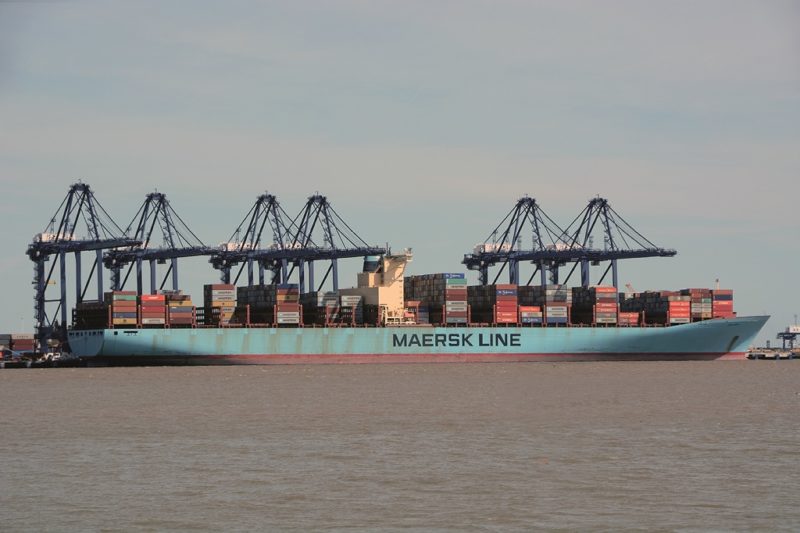
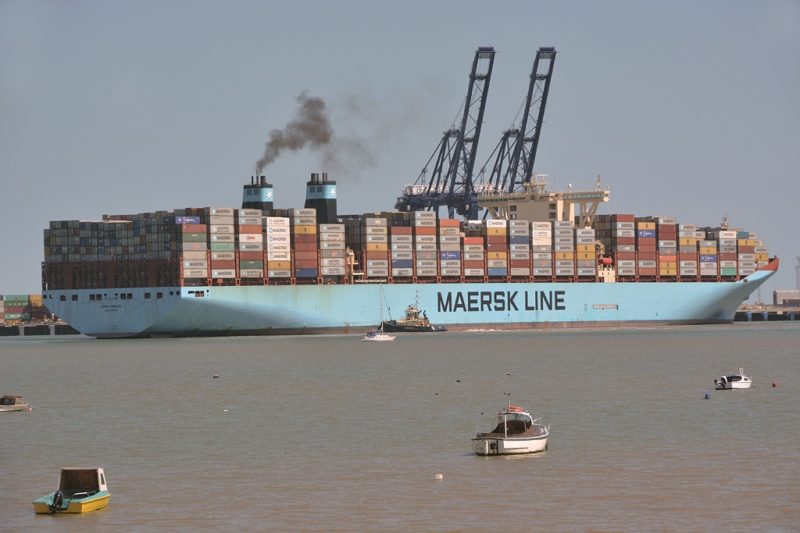
The Townsend Thorsen ferries operating this service were European Gateway of 3,335 grt built in 1975 by the Schichau Unterweser A.G. yard in Bremerhaven as Yard number 2256. She had accommodation for 132 passengers and had dimensions of overall length 386.0 feet and a moulded beam of 66.6 feet. She was unfortunately sunk by collision in 1982 with Speedlink Vanguard off Felixstowe, with six people losing their lives after she capsized from the 34 passengers and 36 crew onboard. Two ‘Super Viking’ ferries of 6,387 grt with dimensions of overall length of 143.7 metres, moulded beam of 23.4 metres and moulded depth of 12.0 metres, and able to carry 1,200 passengers in air-conditioned cabins and public rooms, were completed in 1975 by the Aalborg Verft yard, and were in operation from Felixstowe in 1984.
The Port of Felixstowe ownership had passed to European Ferries Ltd., holding company of Townsend Thoresen, in 1976, with a purpose-built passenger and freight terminal completed in 1978. European Ferries Ltd. became part of P. & O. in November 1987 for £345 million, and later in June 1991 P. & O. sold the Port of Felixstowe to Hutchison Whampoa of Hong Kong with 25% owned by OOCL of Hong Kong. In June 1994, this 25% stake was bought out by Hutchison International Port Holdings for £50 million and is the current owner of the port. The P. & O. passenger and freight service to Zeebrugge ended in 2002.
On 6th January 1992, the Norfolk Line, owned by Maersk of Denmark, transferred its trade from Great Yarmouth to Scheveningen in Holland to Felixstowe ro-ro terminal next to the original Felixstowe Dock, as their new larger sisters, the Japanese built Maersk Importer and Maersk Exporter, could not be accommodated there. The pair had service speeds of 18.6 knots on the seven hour voyage from Scheveningen to Felixstowe, and they ran in company with the ro-ro sisters Maersk Flanders (ex Duke of Flanders) and Maersk Anglia (ex Duke of Anglia). In 2000, this pair were replaced by two new sisters with the same names, and also were exact sisters of Maersk Importer and Maersk Exporter. All four sisters had ‘Maersk’ blue hulls with ‘Norfolk Line’ in large capitals on their hulls and transported 114 trailers with accommodation for a dozen drivers on their four times daily services at 0600, 1200, 1900 and 2359 hours.
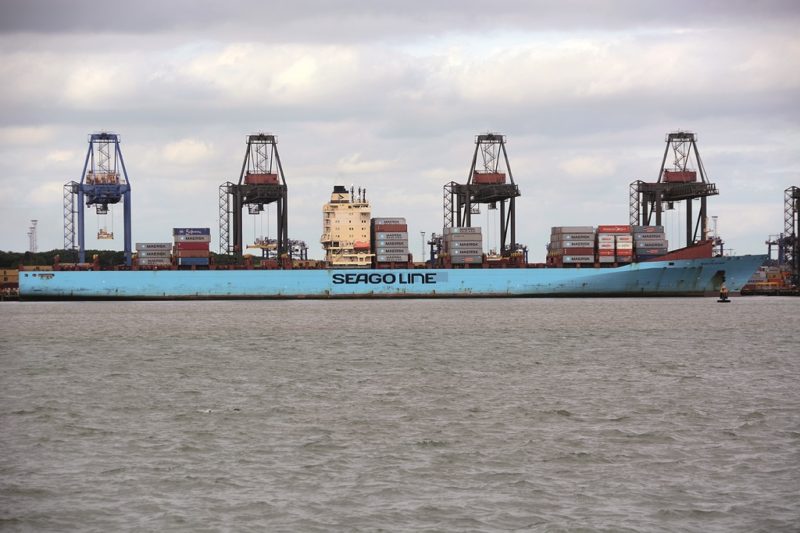
GROWTH OF PORT OF FELIXSTOWE CONTAINER OPERATIONS
Land acquisition to the north and west of Landguard Container Terminal began in 1979 with some purchased from Trinity College in Cambridge, hence the name of the Trinity Terminal. The port was to eventually cover 3,383 hectares, although the current Trinity Terminal operations cover only 136.7 hectares and the South/Landguard Terminal operations cover only 47.4 hectares. There needed to be a ‘buffer’ safety zone with the town of Felixstowe to the north and a Nature Reserve to the west of Trinity Terminal. Container throughput had reached 252,802 TEU in 1980 with the completion of the second phase of the Landguard Terminal. The expansion to 500,000 TEU in 1985, and to one million TEU in 1987, to 2.1 million TEU in 1996, 2.7 million TEU in 1999, 3.0 million TEU in 2006, 3.3 million TEU in 2007, and to the huge throughput of 4.2 million TEU in 2017 and 4.5 million TEU per year in 2020 and was achieved in four decades. The Dooley (1981), and Walton (1981) Terminals were followed by the Trinity Terminal, the latter being the first U.K. Post-Panamax container facility and was built in phases throughout the 1980s and 1990s with final phase completed in 2004 with 17 huge gantry cranes in operation.
Walton Container Terminal was a separately operated terminal by OOCL of Hong Kong, which eventually brought the whole port into Hong Kong ownership. In October 1981, a new weekly co-ordinated container service, the St. Lawrence Co-ordinated Service (SLCS), was begun from the Walton Container Terminal at Felixstowe to Montreal by the ‘big three’ of the Transatlantic container trades of the time. OOCL via its subsidiary Manchester Liners Ltd., DART Container Line, and Canadian Pacific (CP Ships) used four ships on this service in Manchester Challenge (ex Dart America), CP Ambassador (ex Dart Atlantic), Canadian Explorer (ex Dart Canada), and Dart Europe (later CMB Europe). Three had a capacity for 1,595 TEU of containers with a service speed of 23 knots and were built in 1970/71, with two built by Swan Hunter Shipbuilders on the Tyne, and one by Cockerill Yards in Belgium, and Dart Canada was built in 1978.
The Ace Consortium used Felixstowe as its European container terminal from its founding in 1975, and was operating eleven fast container ships on a weekly service to the Far East owned by the consortium partners of OOCL, Neptune Orient Lines of Singapore, Korea Shipping Corporation, Cho Yang Shipping Company of Taiwan, Kawasaki Maersk Line (a joint venture of Kawasaki Kisen Kaisha (‘K’ Line) of Japan and Maersk Line of Denmark), Chargeurs Reunis of France and the Franco Belgian Service (FBS). Fast container ships with service speeds of 25 knots were used e.g. Verrazano Bridge and Seven Seas Bridge of ‘K’ Line built in 1973 with capacity for 1,850 TEU of containers. Neptune Jade and Neptune Sapphire, which both called at Felixstowe in February 1981, served along with their sisters Neptune Amber, Neptune Coral, Neptune Crystal, Neptune Diamond and Neptune Garnet of 2,250 TEU capacity all on Round the World services. Oriental Chief owned by OOCL also called at Felixstowe in February 1981, she was of 31,292 grt and 2,525 TEU capacity and had ten sisters all on Round the World services. She was renamed OOCL Exporter in 1988 when a standard OOCL nomenclature was adopted.
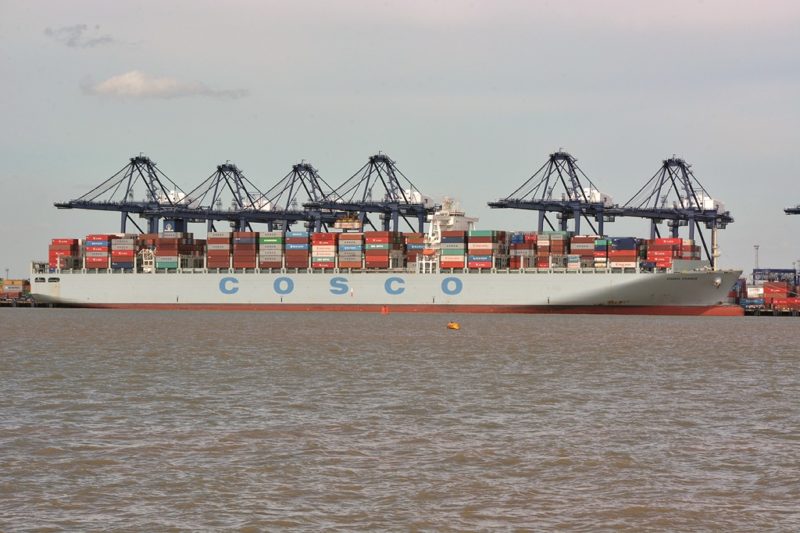
In 2008, work began on the construction and reconfiguration of the South and Landguard terminals creating 1,300 metres of quay length with 750 metres completed by the end of 2010 and the full scheme completed by 2014. A dozen huge container gantry cranes are currently in operation on this South/Landguard Terminal, which has an alongside depth of water of 16 metres. Maersk Line has been a close and leading user of the port from the eleven vessels of the ‘L’ class of 3,016 TEU capacity built between 1980 and 1985, to the much larger Maersk Line ‘Triple E’ class of 15,500 TEU capacity and launched from 2013. Emma Maersk of 15,500 TEU arrived in the port in November 2006 on her maiden call with Christmas imports. Maersk Gateshead, a unit of the twelve ship ‘G’ class of 4,338 TEU capacity, had arrived from her Hyundai builders yard in South Korea in December 2002 via the Suez Canal at the end of her maiden voyage.
Recent record loadings by the Port of Felixstowe include 23,773 TEU on 12th January 2022 on the vessel MSC Diletta which operates on the Maersk Line/MSC joint 2M Alliance Griffin/AE55 Far East service. This record loading was beaten on 8th March 2022 by handling 25,582 TEU of containers unloaded and loaded on Moscow Maersk on 1st March 2022, and by unloading and loading 27,961 TEU of containers on MSC Amelia on 8th March 2022. Moscow Maersk is a ULCV with ten sisters named Madrid Maersk, Munich Maersk, Milan Maersk, Monaco Maersk, Marseille Maersk, Manchester Maersk, Murcia Maersk, Manila Maersk, Mumbai Maersk and Maastricht Maersk. They were built by the Daewoo yard in South Korea during 2017/18 and are of overall length of 400.0 metres with a moulded beam of 59.0 metres and a capacity for 19,630 TEU of containers. The 20 unit class of 18,340 TEU capacity were built during 2013/15 and also have ‘M’ names in Maersk McKinley Moller, Madison Maersk, Magelby Maersk, Majestic Maersk, Marchen Maersk, Maren Maersk, Marete Maersk, Margrethe Maersk, Maribo Maersk, Marie Maersk, Marit Maersk, Marstal Maersk, Mary Maersk, Mathilde Maersk, Matz Maersk, Mayview Maersk, Mette Maersk, Mogens Maersk, Morten Maersk, and Munkebo Maersk.
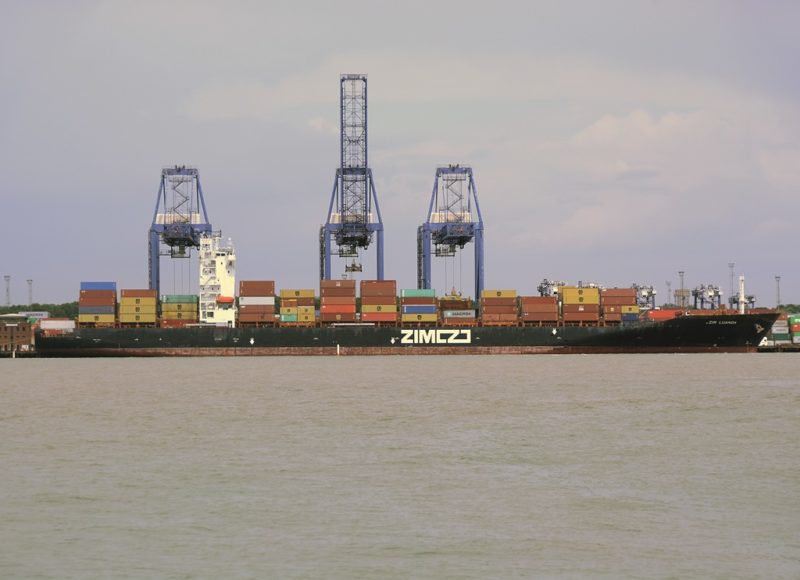
The Maersk ‘H’ class of eleven Neomax container ships of 15,250 TEU capacity and 153,774 grt and 162,051 dwt included the unfortunate Maersk Honam that caught fire on her maiden voyage on 6th March 2018 when 900 miles south east of Salalah in Oman while on a voyage from Singapore to Suez. It took over three days for salvage teams from three salvage ships to put out the blaze that broke out in number three cargo hold, and unfortunately four crew members lost their lives. The ship was so badly damaged that she had to be completely rebuilt at the yard of her builders, and was renamed Maersk Halifax on completion of rebuilding. The sisters are all from the Hyundai yard of overall length of 353.0 metres with a moulded beam of 53.5 metres, moulded depth of 30.0 metres, and a loaded draft of 15.0 metres, and are named Maersk Hidalgo, Maersk Hong Kong, Maersk Horsburgh, Maersk Hanoi, Maersk Hangzhou, Maersk Hamburg, Maersk Herrera, Maersk Havana, Maersk Huacho and Maersk Houston.
Seago Line was founded in 2011 as an independent entity within the Maersk Line Group as an Intra-European carrier, with a white funnel and a double arrow head device, and Maersk blue hulls with ‘SEAGO LINE’ in capitals. The Felixstowe service to the Baltic includes calls at Rotterdam, Antwerp, Bremerhaven, Copenhagen and Kotka in Finland by a group of five ships of 4,196 TEU including Seago Felixstowe, Seago Antwerp, Seago Bremerhaven, together with Venta Maersk, Vilnia Maersk and Vuokski Maersk of 2,500 TEU capacity. Seago Istanbul and Seago Piraeus of 4,196 TEU operate to Mediterranean ports.
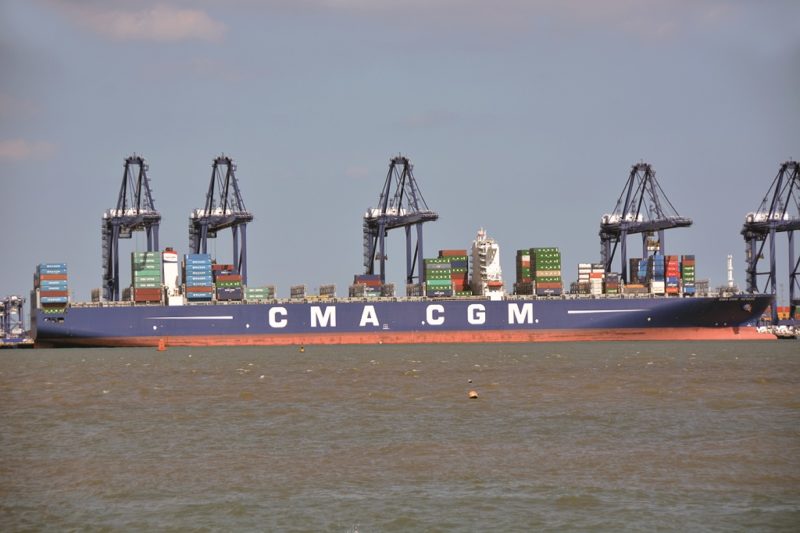
Gianluigi Aponte founded Mediterranean Shipping Company (MSC) in 1970 with one small second hand coaster, Patricia of 1,750 grt and built in 1955. Twenty years later, he had begun his ‘MSC’ prefix nomenclature with two ships, MSC Chiara and MSC Sabrina, in a fleet of thirty second general cargo ships, some converted to cellular container ships. New container ships were then built in classes from 2005, with eight units of 5,600 TEU, 20 ships of 8,200 TEU, 20 ships of 9,200 TEU although the last four units were stretched to 11,612 TEU in 2009. In 2010, a larger class of 30 units of between 13,050 TEU to 13,300 TEU began to be completed over a two year period.
The mega container ship MSC Oscar of 19,224 TEU capacity was handled at Berths 8 and 9 at the end of her maiden voyage from the Far East in 2014. All of her mega sized sisters have also visited the port including MSC Allegra, MSC Clara, MSC Diana, MSC Ditta, MSC Eloine, MSC Erica, MSC Jade, MSC Maya, MSC Mirja, MSC Oliver, MSC Sveva, MSC Stella, MSC Dorine and MSC Zoe. This class have an overall length of 396.0 metres, and in June 2022 MSC La Spezia with an overall length of 366 metres, and MSC Marianna, MSC Ingrid, MSC Mumbai with overall lengths of between 300.0 metres and 330.0 metres also visited the port.
The new Neomax MSC class of ten ULCVs of 92,500 gt and 110,800 dwt were built by the Jinhai yard in China during 2016/17. MSC Sofia Celeste is the lead ship of the class and is registered in Portugal as she regularly calls at Sines on her Northern Europe to East Coast North America and West Coast of South America service. She made her maiden call at Philadelphia on 8th August 2016 when she docked after sailing from Rotterdam, Felixstowe and Sines. This Neomax class have overall lengths of 300.0 metres and a moulded beam of 48.2 metres. Two chartered vessels calling at Felixstowe in June 2022 were the German owned Henrika Schulte of 34,677 dwt owned by the Schulte Group arriving from Gydnia, and the former Japanese owned Catherine C (ex NYK Lode Star) of 300.0 metres in length which sailed for Le Havre as her next port of call.
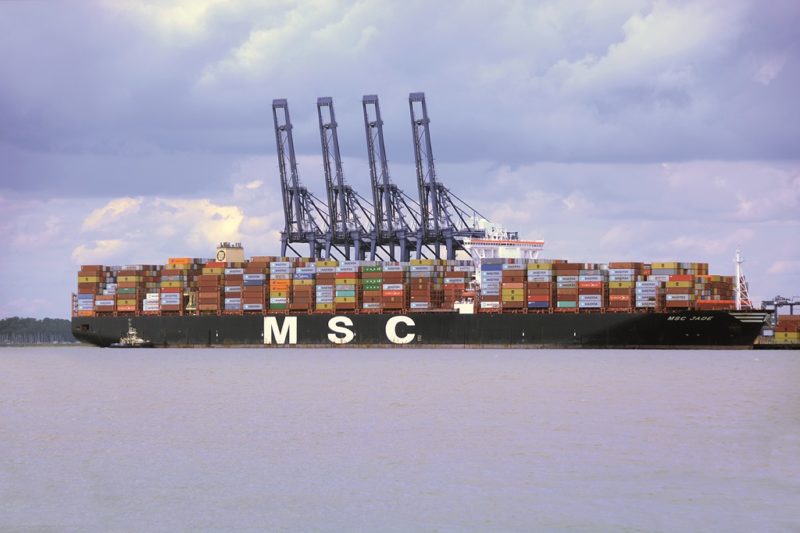
Giant container ships owned or chartered by COSCO of China, Evergreen Marine of Taiwan, Zim Line and OOCL of Hong Kong also arrived in June 2022. OOCL of Hong Kong were formerly 25% owners of the port and continue to be regular visitors. The ten unit Neomax class of 13,208 TEU are OOCL Bangkok, OOCL Berlin, OOCL Brussels, OOCL Chongxing, OOCL Egypt, OOCL France, OOCL Korea, OOCL Malaysia, OOCL Poland and OOCL Singapore, while the six unit ULCV class of 21,415 TEU from the Samsung yard in South Korea during 2017/18 are OOCL Germany, OOCL Hong Kong, OOCL Japan, OOCL Indonesia, OOCL Scandinavia and OOCL United Kingdom. These OLCVs call monthly at Felixstowe, with OOCL Indonesia having arrived on 21st November 2020. The chartered OOCL Long Beach of 8,063 TEU and built in 2003 for Seamax Shipping of the U.S.A. arrived in the port in June 2022 as Seamax Bridgeport from Mundra in India on charter to MSC.
The twin funnelled ULCV Ever Ace of 24,000 TEU capacity arrived in the port on 13th September 2021, having sailed from Qindao in China in July and also called at Rotterdam and Hamburg. Evergreen Marine had launched its first service on the Asia to Europe container service with ships of just 1,200 TEU capacity in 1979, Ever Ace was the biggest container ship in the world when completed in 2021. The eleven unit ‘A’ class are being completed during 2021/23, and include Ever Ace, Ever Act, Ever Aim, Ever Alp, Ever Arm, Ever Art, Ever Apex, Ever Atop and ten unnamed ships at the time of writing.
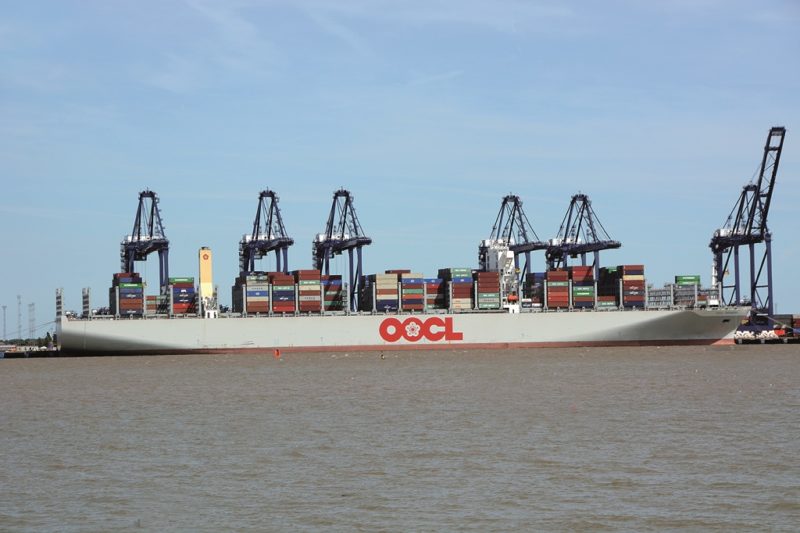
Ever Given of the eleven unit ‘G’ class of 20,200 TEU achieved notoriety when she ran aground in the Suez Canal in March 2021, and was only freed over a week later and had caused a major logjam in the Far East to Europe trade. She was then held in the Great Bitter Lake for four months over a $900 million compensation claim by the Suez Canal Authority, which was reduced by one third before agreement was reached. She reached Rotterdam on 29th July 2021 and then Felixstowe on 3rd August 2021 for unloading.
COSCO of China has a huge fleet of 175 owned and chartered container ships over 1,000 TEU and up to 21,237 TEU capacity, with weekly calls at Felixstowe in June 2022. Cosco Vietnam of 8,208 TEU capacity is chartered from SeaSpan of Vancouver, Cosco America of 10,046 TEU capacity also called, and Cosco Shipping Galaxy and Cosco Shipping Star are two of over twenty new container ships of 21,237 TEU capacity that have been completed since 2018/19. The ULCV class sisters are Cosco Shipping Planet, Cosco Shipping Solar, Cosco Shipping Galaxy, Cosco Shipping Universe, Cosco Shipping Nebula, Cosco Shipping Gemini, Cosco Shipping Sagittarius, Cosco Shipping Virgo, Cosco Shipping Taurus, Cosco Shipping Libra, Cosco Shipping Aquarius, Cosco Shipping Pisces, Cosco Shipping Aries, Cosco Shipping Scorpio, Cosco Shipping Leo, Cosco Shipping Capricorn, CSCL Arctic Ocean, CSCL Pacific Ocean, CSCL Atlantic Ocean, CSCL Indian Ocean and CSCL Globe. The China Shipping Container Lines (CSCL), part of COSCO, ‘Planet’ class of 14,074 TEU capacity also call at Felixstowe with CSCL Mars, CSCL Mercury, CSCL Jupiter, CSCL Saturn, CSCL Venus, CSCL Uranus, CSCL Neptune, and CSCL Star.
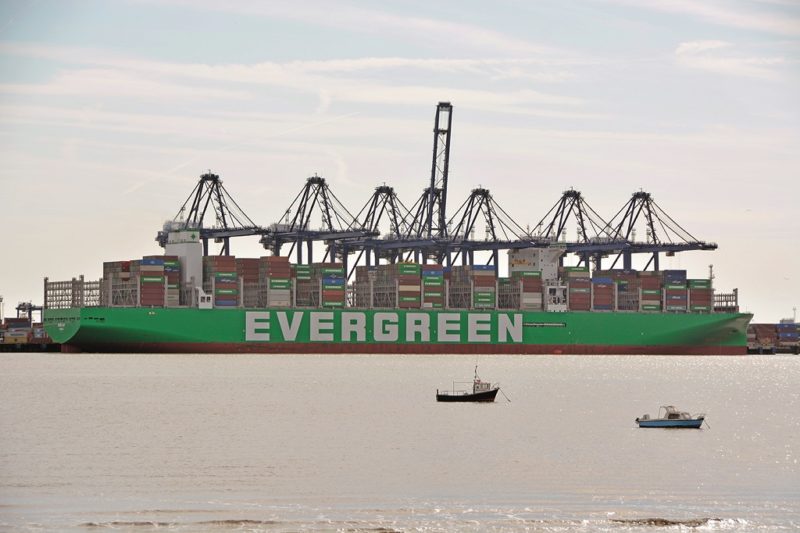
Zim Line of Israel have twenty container ships with ‘Zim’ prefixes to their names, and were founded in 1945 at Haifa with a branch office in Norfolk (Va) for Transatlantic services. Zim Antwerp and Zim Rotterdam are of 10,090 TEU capacity, while Zim China of 4,250 TEU capacity arrived at Felixstowe on 4th June 2022 from Valencia with Rotterdam as her next port of call. Zim Line container ships are mostly of 5,500 TEU capacity, with a further 14 units of this size on order for delivery from 2023 onwards on long term charter from Navios Maritime Partners and MPC Capital A.G.
The CMA CGM French registered ULCV, CMA CGM Jean Mermoz, arrived at Berths 8/9 on 7th June 2022 on the French Asia Line (FAL) service from the Far East with a call at Algiers. She is of overall length 400.0 metres and 23,112 TEU capacity, with two sisters named CMA CGM Louis Bleriot and CMA CGM Antoine de Saint-Exupery and delivered in 2018. A further nine LNG powered sisters were completed during 2020/21 as CMA CGM Jacques Saade, CMA CGM Palais Royal, CMA CGM Rivoli, CMA CGM Concorde, CMA CGM Sorbonne, CMA CGM Champs Elysses, CMA CGM Louvre, CMA CGM Montmartre and CMA CGM Trocadero. The previous ULCV class of up to 17,859 TEU capacity was of 14 ships named after famous explorers and was completed when the last ship was delivered in 2015.
CMA CGM (U.K.) Ltd. book slot space on chartered vessels for the services to the Baltic, U.S.A. and the Middle East. The subsidiary of Delmas Armement used to call on the West African weekly service with containers and forestry products e.g. Marie Delmas of 2,200 TEU capacity called in June 2008, she was of 26,061 gt and was built in China in 2001. Delmas Armement were acquired in 2006 from the Bollore Group for 600 million euros, and the Loop 1 weekly service from Felixstowe began on 18th October 2003 with the sailing of Nicholas Delmas. Delmas Armement ceased trading on 1st March 2016.
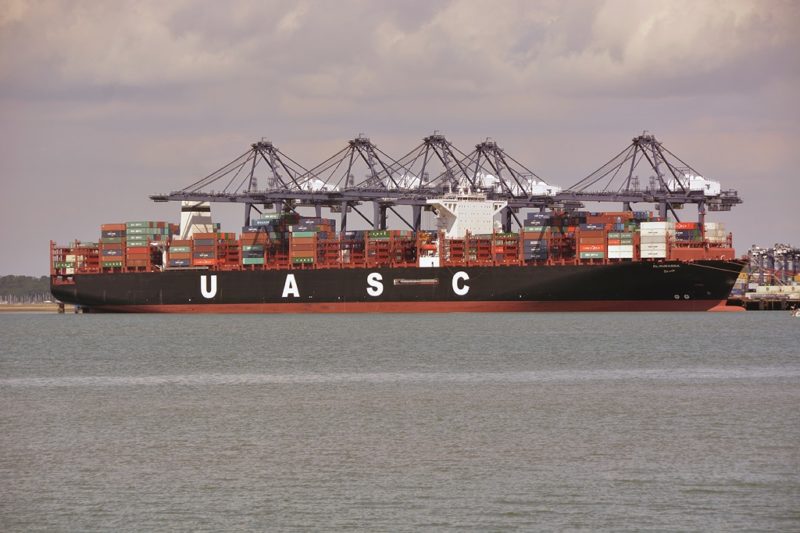
Jazan of 6,921 TEU capacity and overall length of 306.0 metres, owned by the United Arab Shipping Corporation (UASC), arrived at Felixstowe on 6th June 2022 for discharge. UASC was taken over by Hapag-Lloyd A.G. on 24th May 2017 to form a very large group operating over one hundred container ships. The Hapag ships have ‘Express’ suffixes to their names, with the biggest container ships in this merged fleet being the six unit Al Dahna class of 19,870 TEU capacity of Al Dahna, Al Muraykh, Al Nefud, Al Zubara, Barzan and Tihama.
Hamburg Sűd has a big fleet of fifty container ships in sizes from 3,800 TEU capacity to 10,600 TEU capacity, and has a long history of 150 years in shipping from 1871. The weekly services from Felixstowe are to Turkish Ports (Gebze, Kumport, Gemlik and Aliaga), South Mediterranean ports (Alexandria (Dekheila), Port Said, Beirut, Lattakia, Mersin and Tripoli), and East Mediterranean ports (Malta, Salerno, Piraeus, Limassol, Haifa, Ashdod, and Alexandria).
Yang Ming Line is a Taiwan State controlled container ship fleet founded in 1973 and now has ninety owned and chartered ships. YM Evolution of 4,662 TEU capacity arrived at Trinity Terminal on 19th June 2022 and was built in 2014. Larger and later ‘YM’ classes include ten ‘U’ class of 8,236 TEU capacity and built between 2008 and 2012, twenty ‘W’ class of 14,220 TEU capacity and built between 2015 and 2019, and ten ‘T’ class of 12,750 TEU capacity and built between 2020 and 2022.
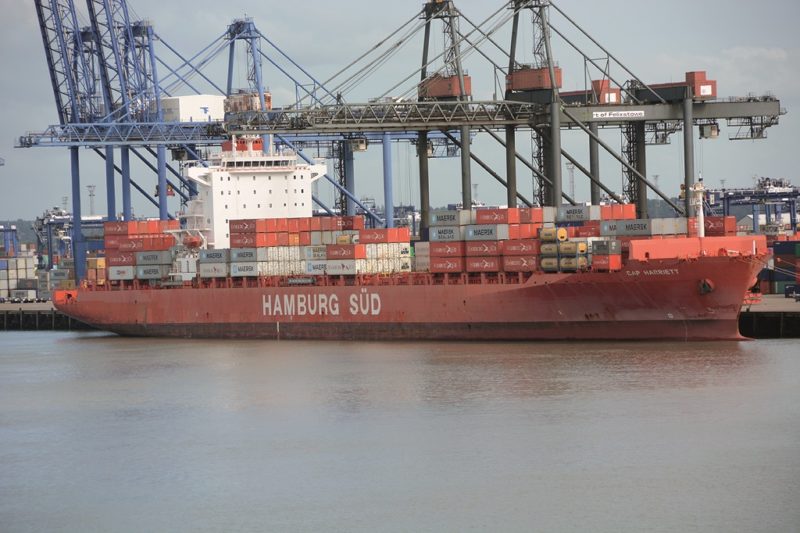
Smaller shipping lines that have served Portugal, Spain, Italy and Eastern Mediterranean ports include Willie Shipping (Charles M. Willie & Company of Cardiff), whose Celtic King loaded at Felixstowe of 6,250 dwt on 2nd November 2000 for Iskenderun in Italy, Borchard Lines, whose chartered vessels load at Felixstowe today on a 28 day schedule calling at Salerno, Izmire and Eastern Mediterranean ports, and the short-lived Frellsen Line of Copenhagen whose Frellsen Eva of 4,200 dwt loaded at Felixstowe on 29th January 1981 for Istanbul and Samsun in Turkey.
A special visitor at the Port of Felixstowe on 14th June 2022 was the polar research vessel Sir David Attenborough at Trinity Terminal to unload containers at the end of her first six month voyage to Port Stanley and Antarctica. She is owned by the Natural Environment Research Council and operated by the British Antarctic Survey (BAS) based at Cambridge.
She has an overall length of 129.0 metres, moulded beam of 24.0 metres, and a loaded draft of 7.0 metres, gross tonnage of 16,300, cost £200 million, and is commanded by Capt. Will Whatley. She was launched on 14th July 2018 at Birkenhead and made her London debut at Greenwich at the end of October 2021. She has a crew of 30 and carries up to 60 scientists on each voyage, with refuelling only necessary at the end of two months of continuous travel. She has a moon pool, and rock corers, drills and samplers for research into the sea floor, and can conduct acoustic surveying into the depths of the oceans.
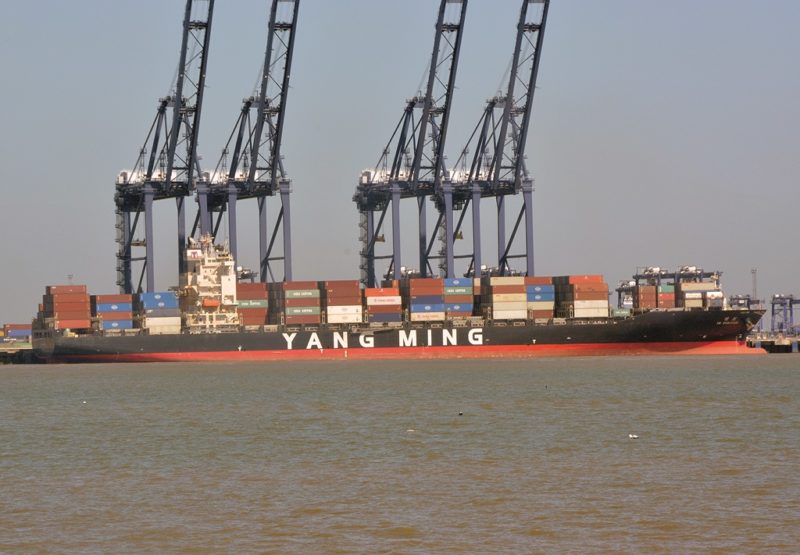
PORT OF FELIXSTOWE FACILITIES
There are over two dozen shipping companies using the terminals at the Port of Felixstowe today, with three rail terminals (North, Central and South) to bring in and take out containers for Freightliner, GB Railfreight, DB Schenker Cargo (U.K.) and Maritime Transport Ltd. rail connections to rail hubs throughout the U.K., with the 38th daily rail link recently inaugurated.
These shipping companies are Maersk Line, MSC (Mediterranean Shipping Company), CMA CGM U.K. Ltd., APL U.K., BG Freight Line B.V., Borchard Lines, COSCO Shipping, CSCL of China, Deco Lines, DFDS Seaways, Evergreen Marine, Hamburg Sud, Hyundai Merchant Marine (HMM), OOCL, Safmarine, Seago Line, Turkon Line, Unifeeder, WEC, X-Press Container Line, Zim Line, Iscont Line, SM Line and Feederlink. The size and scale of the facilities is now given:-
TRINITY CONTAINER TERMINAL
Terminal Area 136.7 hectares
Gantry Cranes 17 with lifts outward of between 18 and 23 containers wide
Yard Storage Capacity 102,000 TEU
Quay Length 2,354 metres
Deep Sea Berths 7 numbered from 1- 7
Alongside Depth 11.6 to 16.5 metres to accommodate ULCV container ships

Stacking Cranes 48 Rubber Tyred Cranes of 40 tonnes capacity
Forklifts 10 High Stackers for Empties, 4 Top Loaders (45 tonnes)
Reefer plugs 1,600
Twin Lift Two container lift with a heavy lift capacity of 85 tonnes
Trinity Terminal was developed with the help of Government grants, and now has 1,600 reefer plugs for refrigerated containers and is the leading U.K. port container terminal for imports of meat, dairy products e.g. concentrated milk, and fruit e.g. kiwi fruit, oranges and other citrus fruit.
The Trinity III expansion involved dredging 900,000m3 of material from the area between 1998 and 2004.
SOUTH/LANDGUARD CONTAINER TERMINAL
Terminal Area 47.4 hectares
Gantry Cranes 12 with 60 metre outreach (24 containers wide)
Yard Storage Capacity 50,000 TEU
Quay Length 920.0 metres with extension soon to 1,285.0 metres
Deep Sea Berths 2 numbered 8 and 9
Alongside Depth 16.0 metres with dredging planned to 18.0 metres
Stacking Cranes 34 Rubber Tyred Cranes of 40 tonnes
Forklifts 5 High Stackers for Empties, 2 Top Loaders of 45 tonnes capacity
Reefer Plugs 300
Twin Lift Two container lift with a heavy lift capacity of 70 tonnes
Road hauliers for both Port of Felixstowe terminals use a Vehicle Booking System (VBS) to deliver or collect containers via a web based system to select a time for the visit to enable the port to manage customer demand and provide a faster turnaround.
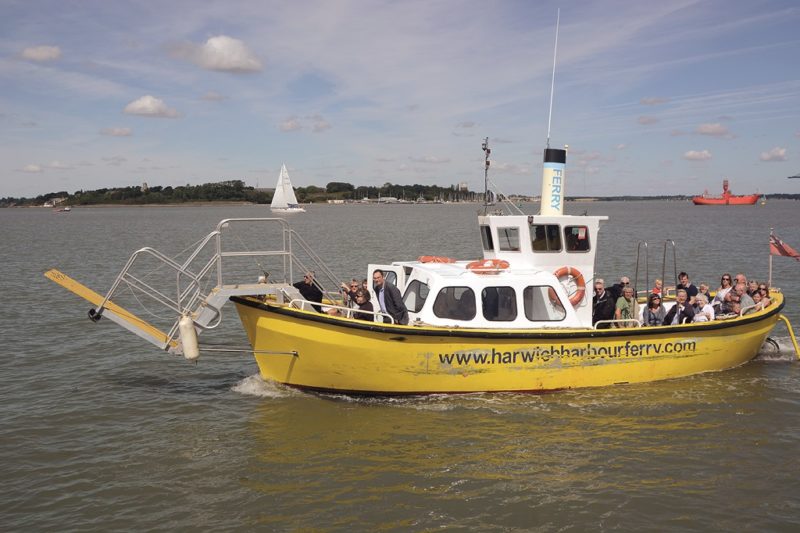
DOOLEY RO-RO TERMINAL
DFDS Seaways acquired the Norfolk Line ro-ro services from Maersk in 2010. These ro-ro operations continue to play an important part in the daily activities of the Port of Felixstowe with two ro-ro berths (3 and 4) for common use but especially for four large twin funnelled freight ro-ros of DFDS Seaways in Acacia Seaways, Gardenia Seaways, Suecia Seaways and Tulipa Seaways of 250 trailer capacity, all with a high reefer content on a daily service to Rotterdam (Vlaardingen).
Tulipa Seaways and Gardenia Seaways are of 32,336 gt and 10,310 dwt with an overall length of 209.6 metres and a moulded beam of 26.0 metres and were completed by Flensburger Schiffs in 2017 and sail under the flag of Lithuania. They have a streamlined and raked navigating bridge and funnel, and a large transverse steel breakwater at the forward end to protect trailers on the open upper deck, with a tripod mast behind the navigating bridge, and a large stern door and ramp.
Dooley Ro-Ro Terminal celebrated 50 years of ro-ro operations on 12th July 2015, and increased the business to ship 265,000 trailers in 2017.
Sixteen weekly sailings are provided by DFDS, and the two berths are lock free with wide ramps, rapid mooring and unmooring, 850 trailer parking slots, and secure camera-controlled operations and secure fencing. In January 2021, work was completed to give Berth 4 a purpose-built, high specification, three lane ramp and floating pontoon linkspan to accommodate the biggest ro-ros in the world. Berth 3 has a 208 metre quay with an alongside depth of 7.3 metres, with an elevating dual lane bridge of 43.6 metres in length, end width of 13.0 metres, and load capacity of 120 tonnes. Maximum vessel length is 209 metres with a beam of 24.4 metres. Berth 4 has a quay length of 246.5 metres with a minimum alongside depth of 9.75 metres with a triple lane bridge, ramp and floating pontoon linkspan.
Road hauliers delivering or collecting trailers for the Dooley Ro-Ro Terminal use a Road Haulier Identity System, with an identity card for drivers that allows them to pass in and out of the port without much hindrance after showing this identity card.
NORTH RAIL TERMINAL
Tracks 9 tracks each of 705 metres in length
Rail mounted gantry 5
Liebherr cranes each of 41 tonnes capacity
Reach Stackers 2 Kalmar reach stackers of 45 tonnes capacity
CENTRAL RAIL TERMINAL
Tracks 8 tracks each of 475 metres in length
Rail mounted gantry2
Liebherr cranes each of
41 tonnes capacity
Reach Stackers 2 Kalmar reach stackers of 45 tonnes capacity
SOUTH RAIL TERMINAL
Tracks 3 tracks each of 440 metres in length
Rail mounted gantry 2
ZPMC gantry cranes of 40 tonnes capacity
Reach Stackers 2 Kalmar reach stackers of 45 tonnes capacity
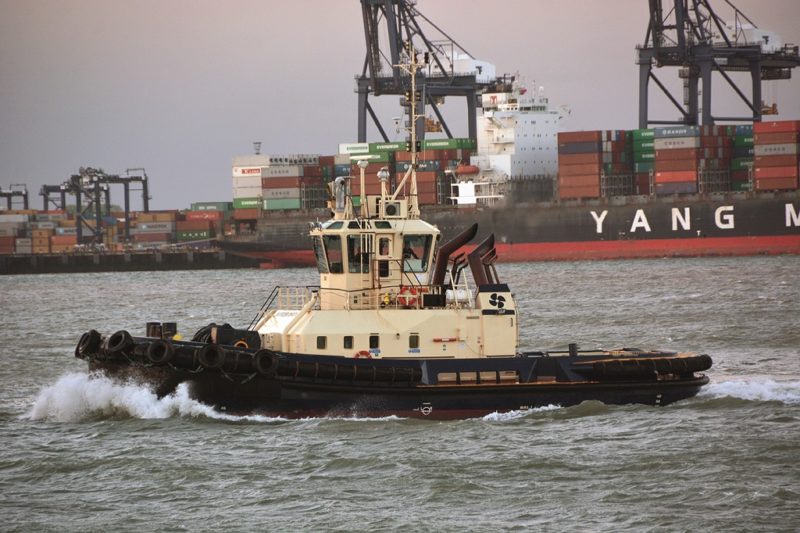
These rail terminals are absolutely essential to the working of the port from Monday to Saturday, and save huge numbers of HGV journeys to and from the port every day on overcrowded U.K. roads and motorways. A freight train removes the equivalent of 76 HGVs from the roads, and some 76 trains arrive and leave the port daily with 38 daily links to sixteen inland locations e.g. to Birch Coppice and Hams Hall in the Midlands, Howbury Park (London), Ditton (Widnes), Rossington, Manchester, Doncaster, Cardiff, Birmingham, Wakefield, Liverpool, Leeds, Rotherham and other rail terminals near other ports e.g. Cleveland near the Port of Tees, South Shields at the Port of Tyne, and Coatbridge near Clyde Port. Hams Hall is the biggest rail freight terminal in the U.K., handling over 125,000 TEU per year eight miles from the outer suburbs of Birmingham. The three Rail Terminals all connect to the Felixstowe Branch Line of the U.K. national rail system.
The three Rail Terminals handled 200,000 containers in 1997, and this figure has quintupled since then to one million TEU per year. Coastal feeder sea links operate mostly daily to Immingham, Tees, Tyne and Grangemouth, with Continental feeder links to Le Havre, Antwerp, Rotterdam, Wilhelmshaven, Bremerhaven and Hamburg. In a commitment to reducing carbon emissions not only on the roads, the Port of Felixstowe recently placed an order for 48 battery powered terminal tractors and 17 zero emission semi-automatic remote controlled electric rubber tyred gantry cranes.
The rail track between Felixstowe and Nuneaton on the West Coast Main Line was upgraded to allow for more freight trains by clearing the route to W10 loading gauge, allowing ‘Hi-Cube’ shipping containers to be carried. The West Coast Main Line had previously been updated to W10 standard, and the route from Nuneaton to Birmingham had been updated to W12 standard. The percentage of ‘Hi -Cube’ containers leaving the Port of Felixstowe by rail in 2012 was 50%. Network Rail completed the gauge enhancement from Ipswich to Peterborough in 2014 at a cost of £291 million.
Four of the container berths can handle ULCV (Ultra Large Container Vessels) of up to 24,000 TEU capacity to ensure that the port remains as the premier container port of the U.K., a position it has held since 1981. Five new Ultra Post Panamax cranes arrived in the port from the ZPMC (Zhenhua Port Machinery Company) factory in China in 2008, and over half of all of the U.K. container trades is now handled at Felixstowe, with over 60% of the Asia/U.K. container trades now passing through the port. The ULCVs now in operation to the Far East still take five weeks of steaming to cover the 9,288 nautical miles from Felixstowe to Singapore. The total of containers handled at the port since its inception as a container port has now reached over 100 million TEUs, and had passed the 70 million TEU mark in 2013.
Project cargo, out of gauge cargo and heavy lift cargo can also be handled by the Port of Felixstowe. The cargo consignment can arrive already securely lashed and loaded onto a flat rack, or this service can be providing by the port with specialist equipment e.g. new nylon webbing slings and specially trained personnel.
Berths 8 and 9 at the South/Landguard Terminal have SWL (Safe Working Limits) of up to 85 tonnes on their ship to shore cranes in a Heavy Lift Mode instead of Standard Lift Mode, but this severely restricts the outreach over the vessel and needs to be carefully considered in the lift planning process.
The maximum SWL heavy lift mode on the ship to shore cranes of Berths 3, 4, 5, 6 and 7 at Trinity Terminal are up to 50 tonnes on a severely reduced outreach.
An example of project cargo was organised by Allseas Global Logistics in September 2011, when a shipment of 174 tonnes of heavy cargo was lifted onboard the container ship Albert Maersk of 7,226 TEU capacity and completed in August 2004 by the Lindo yard at Odense. There was a single item of 40 tonnes in weight and others measuring 4 by 5 by 7 metres, and all were placed on a barge at Aberdeen harbour and towed down the East Coast. All of the cargo was grouped onto flat racks and successfully lifted onboard at Felixstowe.
Since 1st July 2016, every laden export container has been required by law to have a Verified Gross Mass (VGM) or Weight before being lifted on o a vessel in every port of the world. This is to reduce the number of containers lost over the side of container ships in collapses of stacks due to overweight containers, or indeed in the loss of the vessel and her crew. The Port of Felixstowe operates a bespoke solution to this SOLAS VI requirement approved by the MCA of the British Government which does not hinder the transit time or processing time of any container arriving at the port by rail or road.
Security at the Port of Felixstowe has to be tight as it is the premier container port of the U.K., with two purpose-built Border Control Post (BCP) with facilities to enable specialist inspections of all containers and cargo to be undertaken to deter criminal gangs in international smuggling. A third BCP was ready for this essential task when completed in December 2021 in readiness for the additional inspections required after the U.K. left the European Union (EU).
Felixstowe Port Container Services (FPCS) provides a good inspection, cleaning and repair facility for empty containers. Services also include reefer container repair, pre-voyage inspections and cleaning, and container sales. FPCS was founded in 1996 and has achieved a good reputation for container recycling, container conversions, and a purpose-built steam washing system for safe waste treatment. The plant is on the site of the port and very close to the two container terminals for rapid treatment and moving back to yard storage or loading of cargo by specialist teams.
Third party tenant businesses allied to the container shipping industry on site at the port include Seamark Nunn Chandlery, Antony Kettlety Marine Engineers, Allseas Global Logistics, Morrisons Supermarket Warehouses, and Cory Brothers Port and Agency Services. There are a dozen large warehouses on site, as are the Port of Felixstowe Police, Fire and Ambulance services. The seafarer’s welfare charity Apostleship of the Seas provides practical and pastoral support to seafarers and has a Port Chaplain based in the port. Containers arriving or leaving by road in recent years have seen improvements at the Copdock interchange and roundabout at Ipswich between the A14 and A12, with financial support from Hutchison International Port Holdings.
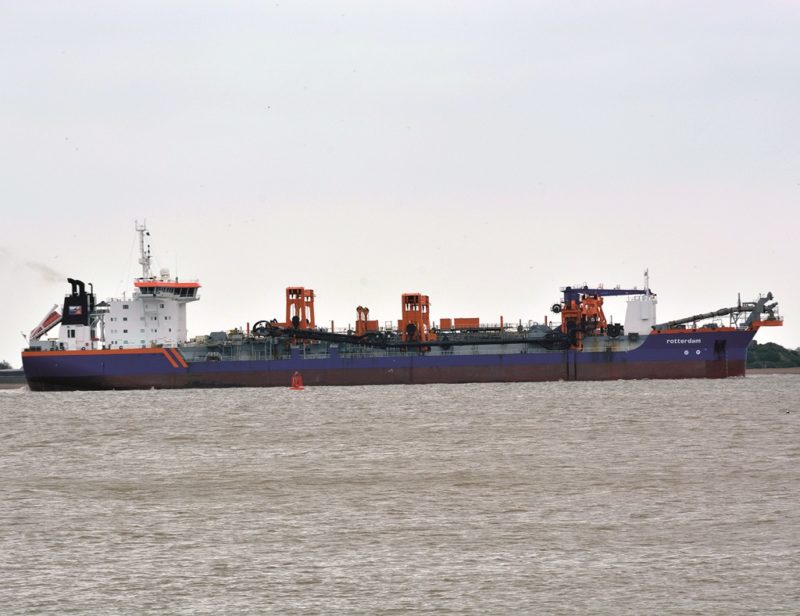
PORT OF FELIXSTOWE MANAGEMENT SYSTEMS
The Port of Felixstowe employs 2,500 to 3,000 people, including three important appointments at Director level of the Port Master, Technical Director and Health and Safety Director. A number of Marine Surveyors report to the Port Master in relation to the following:-
- Marine Operations
- Vessel Traffic System (VTS)
- Waste Management
- Oil and Chemical Pollution and Spill Recovery
- Shipmasters Guide
- Dock Tower Work Instructions
- Mooring Operations
- Trinity House Aids to Navigation
- Risk Assessment and Safe Systems of Work
The Port of Felixstowe holds regular meetings with Harwich Haven Authority (HHA), which runs the sophisticated Harwich VTS (Vessel Traffic System) and is operated on a 24 hour basis to provide a safe and efficient regime for vessel traffic movements, and protection for the natural environment. Regular meetings are also held with the Haven Ports Pilotage Committee (HPPC) with pilots boarding incoming vessels at the Sunk Light Vessel Pilot Station or at the Haven Inner Pilot Station. Pilots communicate directly with Masters of vessels when they are in close proximity or alongside vessels via VHF radio. The Harwich VTS system and pilotage requirements apply to all of the Haven Ports of Harwich, Felixstowe, Mistley, Ipswich and Harwich Navy Yard. Svitzer Towage have been in sole control of ship towage at Felixstowe since April 2007, and have regular meetings with the Port on towing and navigation. Four Svitzer tugs are stationed at Felixstowe with two, Svitzer Kent and Svitzer Deben, having 80 tonnes bollard pull, with two others having escort ability and one having fire-fighting ability in Svitzer Intrepid and Svitzer Shotley.
The Port of Felixstowe Dock Tower is manned 24 hours per day for the co-ordination of all work instructions and marine activities. Constant monitoring and liaison with the Harwich VTS system, tugs, pilots, terminal managers, agents, and steel cable and rope mooring parties is absolutely essential to safe port practice. Masters of all vessels using the Harwich Haven Authority (HHA) ports have to report their ETA three hours in advance, and their ETD two hours in advance. A ship that has given the ETA and has then anchored before embarking the pilot, must give Harwich Operations Centre adequate notice of this, failure to do so can result in delays of providing the pilot. Departing vessels must inform Harwich Operations Centre to confirm the requirement for a pilot 30 minutes before the ETD as a pilot will not be sent if this 30 minute information is not given.
FELIXSTOWE PORT USERS ASSOCIATION (FPUA)
The Port also holds regular meetings with the Felixstowe Port Users Association (FPUA), a vital body to bring to the notice of the port management any important broad issues of any description from port users to ensure port efficiency. FPUA was established in 1969 and is a pro-active independent body for companies who conduct business activity in or through the Port of Felixstowe. It has over 100 members, representing the various members of the port community, as follows:-
Category 1 Shipping Lines
Category 2 Freight Forwarders e.g. Cory Brothers, Denholm Global Logistics
Category 3 Hauliers e.g. VKVP Haulage
Category 4 Warehousing e.g. GMA Warehousing & Transport
Category 5 Port Related Suppliers e.g. IT, Legal, and Fuel
The FPUA strives to do the following:-
- Protect the interests of its members
- Liaise with the Port Authority
- Resolve problems of a localised nature swiftly and efficiently
- Obtain the best possible outcomes for port users of problems
- Represent and promote the port and its members
SUMMARY AND FUTURE PROSPECTS
The Act of Parliament that was set up and signed off in 1875 to create the Felixstowe Railway and Pier Company will soon see the 150th Anniversary of this momentous occasion in 2025 that created a port that was to become the premier container handling port of the U.K.
The change from laborious loading and unloading of small parcels of liner shipping cargo to mass transport in sealed containers with fixed maximum weight levels of 30 tonnes, saw the extinction of the old methods in the Royal Docks on the Thames with tens of thousands of dockers redundant, as well as the many ancillary shipping industry jobs. These men suffered the complete loss of their livelihood, with only retraining and moving to Suffolk to participate in the new methods at the Port of Felixstowe as their only hope of re-employment in the shipping industry that they knew so well. Present port manual employees do not work on fixed days, but are called for shift work of up to twelve hours in duration, day or night, at short notice when required. This is a far cry from long ago from the pensioned Monday to Friday working with weekend working only a rarity when written notice had to be given to the Port of Felixstowe.
In October 2021, serious congestion problems in the port resulted in vessel omissions from the port in their sailing schedules due to an acute shortage of HGV drivers. The port was badly congested with uncollected containers at the start of the busy Christmas restocking period by importers, average dwell time of a container in the port having doubled from 4.5 days in October 2020 to 9.0 days in October 2021. Importers were unable to book haulage, and also there was the need to relocate a huge surplus of empty containers from the port to the Far East, which resulted in very limited yard space for unloading inbound cargo, hence the vessel omissions.
Reports came in of containers being moved and stored in fields near the port. Shipping companies chartered extra container ships simply to move empty containers from Felixstowe and other European ports to the Far East during this congestion crisis. The Maersk Line AE7 Far East to Northern Europe service did not return to the port until the arrival of Monaco Maersk on 6th April 2022.
The future prospects for the Port of Felixstowe are very good indeed, as future developments have been completed, including ten gantry cranes heightened and widened on Berths 6 and 7, 48 electric battery terminal tractors on order, 17 semi-automated rubber tyred gantry cranes on order, approach channel deepening to 16.0 metres underway at a cost of £120 million, and yard storage extension at Berth 9 of 18,000 TEU. The Van Oord trailing suction hopper dredger Rotterdam arrived in the port in June 2022 to begin the dredging work with the help of other backhoe dredgers, the work will be completed in April 2023 with the removal of 18 million tonnes of dredged material.
The maximum total container handling capacity at present at Felixstowe is only 5.0 million TEU per year. Yard storage space could be increased at the Trinity Terminal by using new land to the north towards Trimley to avoid the severe congestion problems of late 2021 occurring again in the future. A new computer system was installed at the Port of Felixstowe on 10th June 2018, but heavy disruption in the first week of operation was reported with 16 hour tailbacks for HGV drivers. Four new semi-automatic remotely controlled rubber tyred (RTG) yard cranes were delivered on 10th April 2019 by the heavy load carrier Zhen Hua 23 from Shanghai for use at Berths 8 and 9. Tags containing container destinations are fitted to HGV driver and passenger windows so that the RTGs can read the tags at the block loading area before completing the move. Containers arriving at the three rail freight terminals with a 28% modal share of port traffic can also be semi-automatic remotely moved.
These RTGs remove the physical stress, to a driver’s back, neck and shoulders suffered in conventional loading as vibrations are eliminated completely. Two ship unloading gantry cranes at Berths 8 and 9 were also undergoing manual testing before being deployed in a semi-automatic mode of operation.
The big lucrative international transhipment trade has never been entered by the U.K., with only very low numbers of coastal U.K. transhipment on small coastal feeder ships, and these British Government transhipment TEU numbers have never been quantified and included in port returns as they are insignificant to most international transhipment made by other container ports. The Port of Rotterdam on the other hand, only 176 miles distant or a short 5.5 hour voyage on a fast ro-ro, handled a huge 36% transhipment figure out of a total throughput of 14.35 million TEU in 2020.
The new Felixstowe Freeport East will be partly located within the port and provide 1.45 million square feet of commercial buildings on a 68 acre site just over 100 metres from Berths 8 and 9 and 500 metres from Trinity Terminal.
The Port of Harwich and the new Gateway 14 business park near the A14 are also included in the new Felixstowe Freeport East, which will be supported by £25 million of Government seed-funding, split between the three sites. Tax benefits are available to Freeport new businesses to enable port growth, with the use of the biggest intermodal rail freight facility in the U.K., and opportunities to trade worldwide.
The Port of Felixstowe has a multitude of services to and from 52 ports in 26 countries around the world including Belgium, Germany, Poland, Spain, Italy, Sweden, Holland, Saudi Arabia, UAE, Iraq, Oman, Egypt, Tanzania, China (9 ports), Indonesia, India, Pakistan, South Korea, Thailand, Vietnam, Australia, New Zealand, Argentina, Bahamas, Mexico, Canada, U.S.A., and with regular transits through both the Panama and Suez Canals.
Financially, the port is very profitable, pre-tax profits were running in the order of £20 million to £30 million for the years from 2010 to 2015, then jumped to £63.04 million in year ended 2016 and to £65.48 million in the year ended 2017. Revenue continued to hold steady at £332.87 million in 2016, £347.92 million in 2017, and £307.58 million in 2020.

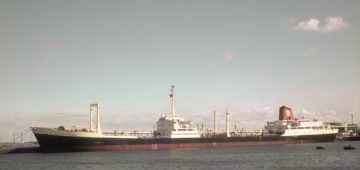



Comments
Sorry, comments are closed for this item